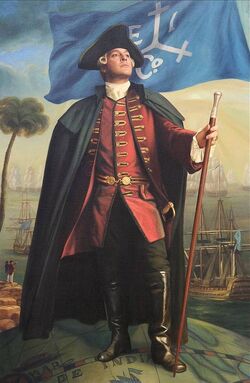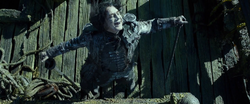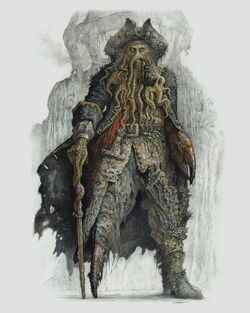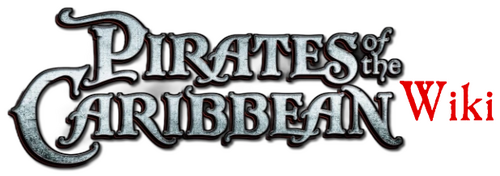
Captain Jack Sparrow holds a cane.
- "Every day with Grandmama is a new adventure. Just don't ever touch her cane, or you'll end up much better acquainted with it than you."
- ―Jack Sparrow on Grandmama
A cane, also referred to as a walking cane or walking stick, was a device of various usages as well as came in many shapes and sizes. As a walking stick, it could be used as a means of support, primarily as an aid for walking, providing or improving stability and balance on the ground, and assist in maintaining a good posture and mobility. They may be used as a support or a balance point when crossing streams, swamps, or other rough terrain; to feel for obstacles in the path; to test water for depth; to enhance the cadence of striding; and as a crutch for people with disabilities. Canes were also known to be used as an instrument of self-defense or punishment and may conceal a hidden blade of a knife or sword to be used as a weapon. Some designs of a cane or walking stick may also serve simply as a popular fashion accessory.
History[]
At some point, as the cursed captain of the Flying Dutchman, Davy Jones had owned an ivory cane, with which the fingers on his right hand extended out in rough tentacles wrapping around the cane.[1]
The crystal-legged pirate Silverback owned a cane—which had a crystal pommel—that he would lean on and hobble back and forth in front of the crew of the Barnacle, lecturing like a school teacher.[2]

Cutler Beckett had at least two canes, one of which served as a branding iron.
Viscount Reginald Marmaduke Bracegirdle-Penwallow, the Director of African Affairs for the East India Trading Company, owned a gold-topped walking stick which came in very handy, especially when he would stagger on land after a long voyage at sea, not being used to the surface not rocking anymore.[3] Cutler Beckett also had a walking cane and branding iron used both as a fashion statement and as a tool of intimidation.[4] Beckett's branding iron glowed red hot once heated in a fire and allowed him to inflict his special kind of punishment by branding pirates with a "P" on the tip of the cane, pressing the searing letter onto the forearm of pirates he captures, leaving them permanently scarred. Most notably used to brand Jack Sparrow,[5][6] Beckett still had this pirate-branding cane over 13 years later.[7][8] Lord Cutler Beckett had an additional cane that he held while posing for a portrait, which could be seen aboard the HMS Endeavour.[9]
Grandmama, one of many relatives of Jack Sparrow and Edward Teague as well as the former Pirate Lord of the Atlantic Ocean, had a wooden cane which also had a very sharp sword hidden inside the cane.[10] The French Pirate Lord Capitaine Chevalle also owned a gold-topped walking stick. During one of his visits to a fellow Pirate Lord Captain Teague, the stick was stolen, and the Frenchman accused his host of thievery, starting a fierce duel. What none of them realized, was that the stick was stolen by Teague's nine-year-old son, Jack Sparrow, and just when the two men had their swords at each other's throats, the boy dropped the stick precisely so it struck both their heads at once, knocking them out instantly, and then ate all the delicacies at the table.[11] Chevalle still carried the gold-headed cane by the Fourth Brethren Court.[6][9] The Chinese Pirate Lord Mistress Ching also had a cane during the Fourth Court.[12]

Armando Salazar holds a sword and a cane.
As Governor Weatherby Swann and his daughter Elizabeth left their home to attend Captain James Norrington's promotion ceremony, one dignitary carried an elegant cane and a wooden box meant to hold Norrington's new ceremonial sword. During his quest to retrieve the Black Pearl, Captain Jack Sparrow once held a cane while visiting Tortuga.[13] By the time Sparrow was brought before King George Augustus years later, Prime Minister Henry Pelham carried a cane.[14] Capitán Armando Salazar of the Spanish Navy owned an elegant cane, notably used after becoming a cursed ghost, which was occasionally carried around by his second in command, Lieutenant Lesaro.[15]
Notable canes[]
- Silverback's cane[2]
- Cutler Beckett's cane[7][8][5][6][9]
- Grandmama's cane[10]
- Chevalle's walking stick[6][9][11]
- Hawk's walking stick[16]
- Davy Jones' ivory cane[1]
- Ching's cane[12]
- Henry Pelham's cane[14]
- Armando Salazar's cane[15]
Behind the scenes[]

Davy Jones holding a cane in concept art for Dead Man's Chest by Crash McCreery.
- Canes first appear, albeit unnamed, in Pirates of the Caribbean: The Curse of the Black Pearl.[13] It was first identified as "cane" in the 2006 reference book Pirates of the Caribbean: The Visual Guide,[5] as well as the 2007 reprint The Complete Visual Guide.[6] The term "walking cane" was first used in the 2010 version of the official Pirates website,[4] while "walking stick" was first identified in the 2011 novel The Price of Freedom.[3]
- In the deleted scene "All is Well" from The Curse of the Black Pearl, Jack Sparrow gives the recently obtained cane to Will Turner right before he enters the Faithful Bride. A confused Will gives the cane to a nearby pirate who uses it to knock down another pirate so he could walk away with his female companion.[17]
- Davy Jones was shown with a cane or walking stick in various media and merchandise, first depicted in concept art by Crash McCreery for Dead Man's Chest.[18][19][20] The term "Walking Stick" was used in at least one action figure of Davy Jones from Zizzle.[21] Jones was also described as having an "ivory cane" in the Dead Man's Chest junior novelization.[1] However, this detail never made it into the final cut of the films.[8][9]
- In Ted Elliott and Terry Rossio's first screenplay draft of Pirates of the Caribbean: At World's End, Governor Weatherby Swann owned a cane.[22]
- Felipe Lara's concept art for Pirates of the Caribbean Online shows the original version of Jolly Roger walking through a cemetery with a cane.[23]
Appearances[]
- Jack Sparrow: The Age of Bronze
- Jack Sparrow: Silver
- Jack Sparrow: The Timekeeper
- Jack Sparrow: Dance of the Hours
- Jack Sparrow: The Tale of Billy Turner and Other Stories
- The Price of Freedom (First identified as walking stick)
- Legends of the Brethren Court: Wild Waters
- Legends of the Brethren Court: Day of the Shadow
- Pirates of the Caribbean: The Curse of the Black Pearl (First appearance)
- Pirates of the Caribbean: Dead Man's Chest
- Pirates of the Caribbean: At World's End
- Pirates of the Caribbean: On Stranger Tides
- Pirates of the Caribbean: Dead Men Tell No Tales
Sources[]
- Pirates of the Caribbean: From the Magic Kingdom to the Movies
- Pirates of the Caribbean: The Visual Guide (First identified as cane)
- Pirates of the Caribbean: The Complete Visual Guide
- The Art of Pirates of the Caribbean
- Bring Me That Horizon: The Making of Pirates of the Caribbean
- DisneyPirates.com (First identified as walking cane)
External links[]
Notes and references[]
- ↑ 1.0 1.1 1.2 Pirates of the Caribbean: Dead Man's Chest (junior novelization), p. 77
- ↑ 2.0 2.1 Jack Sparrow: Silver, p. 16
- ↑ 3.0 3.1 The Price of Freedom, Chapter Four: Cutler Beckett
- ↑ 4.0 4.1 DisneyPirates.com - Archived
- ↑ 5.0 5.1 5.2 Pirates of the Caribbean: The Visual Guide
- ↑ 6.0 6.1 6.2 6.3 6.4 Pirates of the Caribbean: The Complete Visual Guide
- ↑ 7.0 7.1 Pirates of the Caribbean: Dead Man's Chest (junior novelization), p. 23
- ↑ 8.0 8.1 8.2 Pirates of the Caribbean: Dead Man's Chest
- ↑ 9.0 9.1 9.2 9.3 9.4 Pirates of the Caribbean: At World's End
- ↑ 10.0 10.1 Legends of the Brethren Court: Wild Waters, p. 53
- ↑ 11.0 11.1 Legends of the Brethren Court: Day of the Shadow, Chapter Six
- ↑ 12.0 12.1 Pirates of the Caribbean: At World's End (junior novelization), p. 156
- ↑ 13.0 13.1 Pirates of the Caribbean: The Curse of the Black Pearl
- ↑ 14.0 14.1 Pirates of the Caribbean: On Stranger Tides
- ↑ 15.0 15.1 Pirates of the Caribbean: Dead Men Tell No Tales
- ↑ Legends of the Brethren Court: Day of the Shadow, Chapter Nine
- ↑ Pirates of the Caribbean: The Curse of the Black Pearl Deleted Scene: "All is Well"
- ↑ Pirates of the Caribbean: From the Magic Kingdom to the Movies
- ↑ The Art of Pirates of the Caribbean
- ↑ Bring Me That Horizon: The Making of Pirates of the Caribbean
- ↑ Davy Jones - Pirates of the Caribbean - Dead Man's Chest - Series 1 - Zizzle Action Figure - Figure Realm
- ↑ PIRATES OF THE CARIBBEAN: AT WORLD'S END by Ted Elliott & Terry Rossio, original draft
- ↑ Jolly Roger concept art by Felipe Lara

